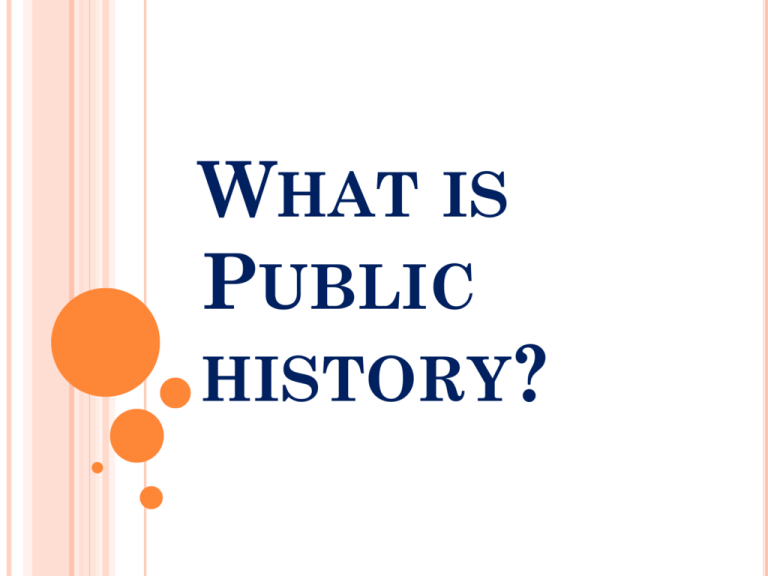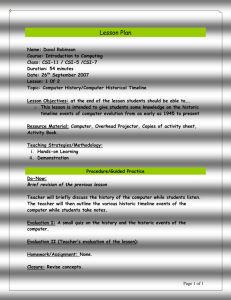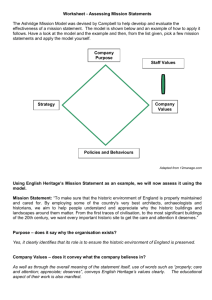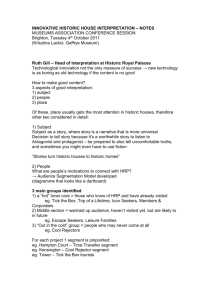What is Public History - National Constitution Center
advertisement

WHAT IS PUBLIC HISTORY? PUBLIC HISTORY: HOW DO WE DEFINE IT? “the presentation of history to the non-academic community” “the popular presentation of the past to a range of audiences” “the employment of historians in history-related work outside academia” “the many ways in which historians recreate and present history to the public- and sometimes with the public” PUBLIC HISTORY: HOW DO WE DEFINE IT? “Public history is history that is seen, heard, read, and interpreted by a popular audience. Public historians expand on the methods of academic history by emphasizing non-traditional evidence and presentation formats, reframing questions, and in the process creating a distinctive historical practice....Public history is also history that belongs to the public. By emphasizing the public context of scholarship, public history trains historians to transform their research to reach audiences outside the academy.” PUBLIC HISTORY Historic site The development of the site for modern public visitation; altered to be a site for instruction on history Exhibits Tours Historic markers Monuments Documentaries Reenactments VS. HISTORY Historic sites Important location of an actual historical event, group, and/or individual that still exists Primary sources Secondary sources STRENGTHS AND Enables a larger audience to access important and sometimes unknown history Conserves historical sites/locations Increases dialogue on important historical issues that still have relevance Creates tourism DRAWBACKS Dilutes historical narrative in order for mass consumption Voices from history usually left out or overemphasized Controversies tend not to be fully addressed Site reconstruction alters historical record (buildings updated) Certain parts of a site developed at the expense of developing entire location can result in decontextualization (one battle field versus all) TYPES OF PUBLIC HISTORY EXHIBITS Museums Permanent Traveling Visitors Centers Historic Buildings Indoors Outdoors Often incorporate the use of artifacts, performance, text, interactive screens, lectures, etc. TYPES OF PUBLIC HISTORY HISTORIC SITES Homes of Important Figures Ex. Betsy Ross House, Benjamin Franklin House Government Buildings Benjamin Franklin’s home in Philadelphia Ex. Independence Hall Battlefields Ex. Gettysburg Betsy Ross House, Philadelphia TYPES OF PUBLIC HISTORY TOURS Audio Ex. IPod tours Walking Exhibit Driving Bus tours Duck boat tours Virtual Ex. Online exhibits http://www.britishmuseum.org/explore/online_tours.aspx http://www.ushmm.org/museum/exhibit/online/ TYPES OF PUBLIC HISTORY PERFORMANCES In-Exhibit Performances Reenactments Reenactment of the Battle of Gettysburg, Gettysburg, PA TYPES OF PUBLIC HISTORY WEBSITES Museums University projects Historic Sites Student projects Ex. National History Day http://constitutioncenter.org/ncc_home_Lan ding.aspx http://www.gwu.edu/~erpapers/ http://www.nps.gov/inde/index.htm http://www.nhd.org/studentsites.htm TYPES OF PUBLIC HISTORY FILMS Documentaries Television Shows Online videos Constitution Hall Pass TYPES OF PUBLIC HISTORY HISTORIC MARKERS DOS AND DON’T’S OF PUBLIC HISTORY DON’T: 1. Make a public history that only appeals to a small group of people. 2. Conduct research without consulting other scholars. 3. Create a public history that is overly long and drawn-out. 4. Use unreliable sources. DO: 1. Create a public history that appeals to a wide ranging audience. 2. Work collaboratively with other scholars to create your public history. 3. Ensure that information is conveyed quickly and can be consumed actively. 4. Maintain high standards of scholarship by using reliable primary and secondary sources. QUIZ: PUBLIC HISTORY OR NOT? “We divided our story into nine chronological chapters, or innings, and insisted as much as possible that the past speak for itself through contemporaneous photographs, drawings, paintings, lithographs, newsreels, and chorus of first-person voices read by distinguished actors and writers. We dissected the ballet of baseball with special cameras that ran at 500 frames a second (instead of 24); interviewed on-camera nearly ninety writers, historians, fans, players and managers: employed the services of twenty-one scholars and more than two dozen patient and talented film editors, delighted in getting to know one of the most remarkable men the game or this country has ever produced, Buck O'Neil; filmed for weeks with the gentle and generous people at the archives of the National Baseball Hall of Fame; and hovered for hours above ancient diamonds in Iowa, West Texas, South Carolina, and a particularly beautiful old park built in a marshy area of Boston called the Fens.” YES! This is public history! About the Film Baseball. Ken Burns, 2010 “An NO! This is not public history! Field of Dreams, starring Kevin Costner, 1989 Iowa corn farmer, hearing voices, interprets them as a command to build a baseball diamond in his fields; he does, and the Chicago Black Sox come.” Trailer, Field of Dreams YES! This is public history! “From May 29 through September 7, 2009, the National Constitution Center will host NAPOLÉON, an exhibition offering visitors a rare opportunity to explore the private life of the Emperor of France and to see beyond the legend to gain an understanding of this complex political leader whose actions reshaped the landscape of Europe and America. Created from the extraordinary collection of First Empire authority and author, Pierre-Jean Chalençon, NAPOLÉON showcases rare, personal belongings of Napoléon I, as well as some of the most famous depictions of him by important artists of the time.” “Jean Valjean, an ex-con, has transformed himself to become mayor and the owner of a factory. But when he is moved to help one of his former workers, Fantine, Valjean's past is brought to light, and he is forced to abandon everything to run from Javert, the chief of police, dead set on bringing him to justice. Nine years later, Cosette, Fantine's child, has been raised by Valjean and has fallen in love with Marius, a fighter in the French revolution (after whom another, named Eponine, also pines). With Javert on the hunt and a revolution tearing the city apart, in the end, everyone is forced to question what they're willing to sacrifice in pursuit of love and justice. No! This is not public history! Based on the novel by Victor Hugo.” SUMMARY QUESTIONS What is public history? Why is public history important? Where do we find public history? Who creates public history?








